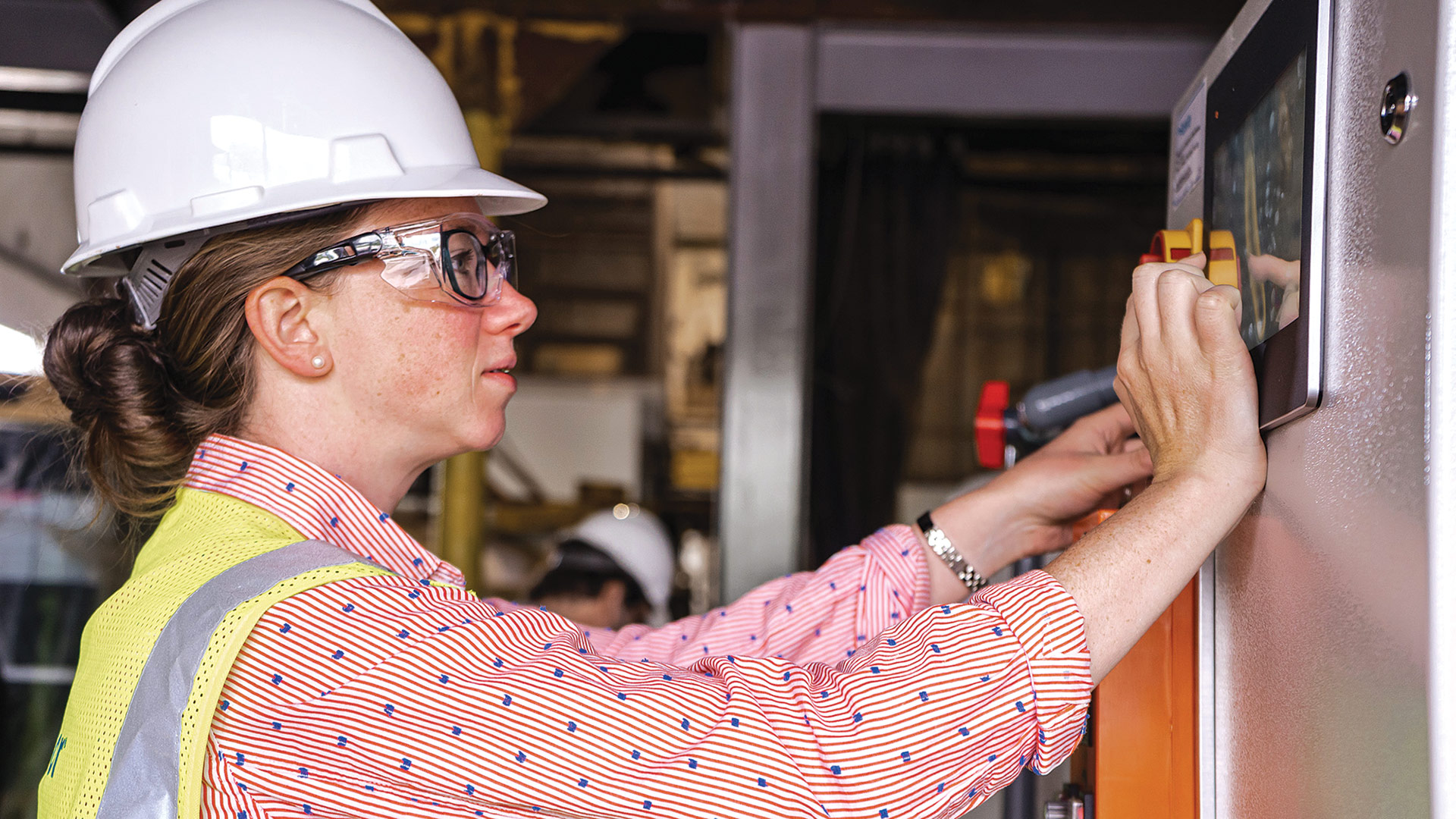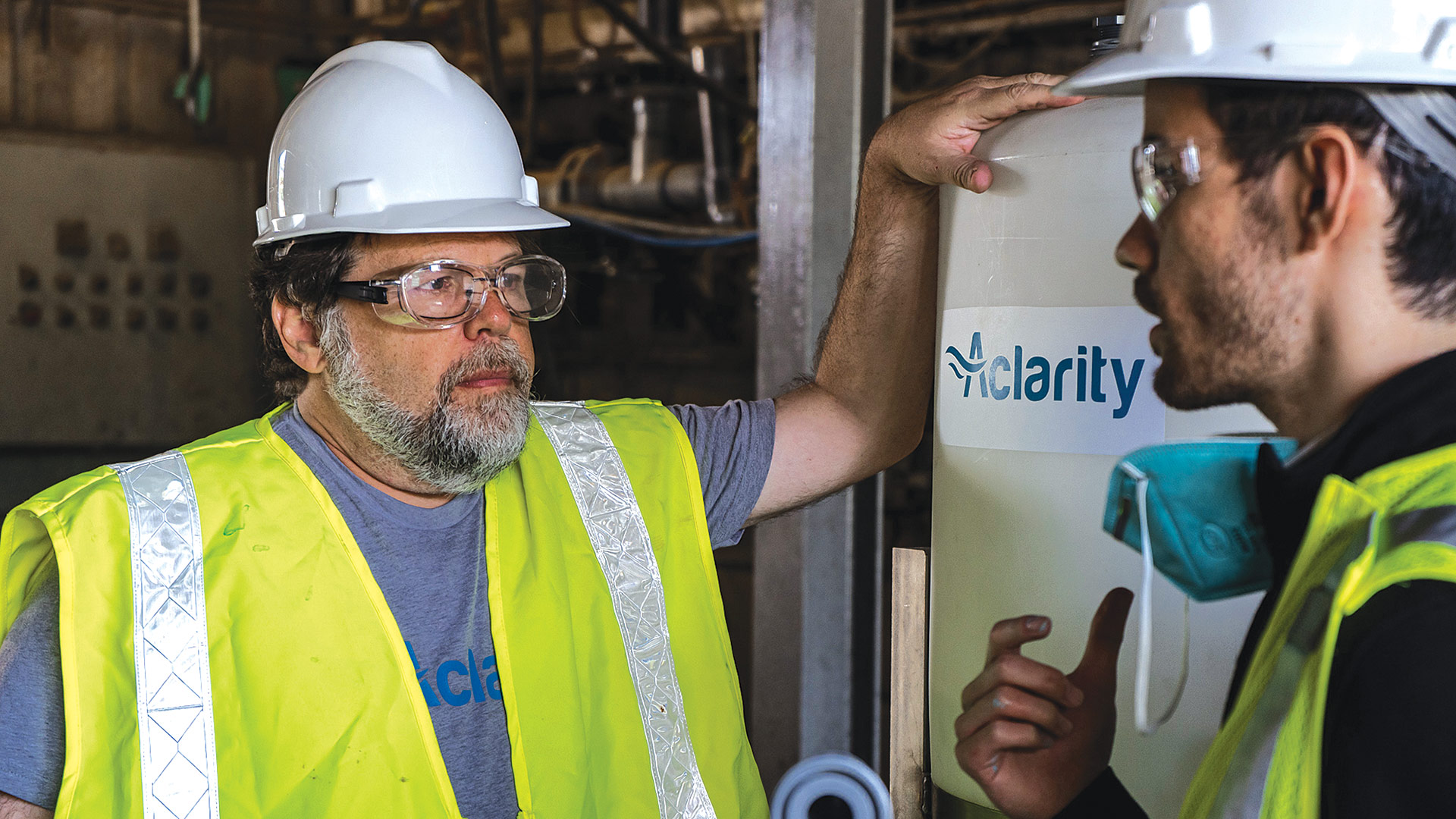Aclarity Seeks To Bring Its Unique Water-Treatment Technology To The Next Level
Published on by Water Network Research, Official research team of The Water Network in Business
Several years ago, BusinessWest told the early part of the Aclarity story, of how CEO Julie Bliss Mullen, as part of her PhD research, discovered an electrochemical technology that could treat water by passing a small electric current through it to destroy contaminants.
“They’re nicknamed the ‘forever chemicals’ because they don’t break down in nature. The bonds in them are so strong that essentially nothing natural breaks them down.”
It immediately stood out from other solutions on the market due to both the lack of resulting waste products and its versatility. So in 2017, she co-founded Aclarity, which won the top award at the UMass Innovation Challenge, claiming $26,000 in seed money to help jump-start the company.

Julie Bliss Mullen co-founded Aclarity to sustainably and cost-effectively clean the world’s most challenging waters.
Essentially, she explains, electricity is applied to an anode and cathode, water flows through the reactor, and contaminants are destroyed by strong oxidants such as free electrons (which break the PFAS bonds), hydroxyl radicals, ozone, and chlorine that are generated inside of the Aclarity reactor. The result is harmless byproducts — essentially water that is free of PFAS and other harmful contaminants.
“Think about a battery,” Schneider said. “You have electrodes in there, and it takes chemical energy and turns it into electrical energy. We do the opposite. We put electrical current into the electrodes, and chemistry occurs. What we’re trying to do is break down a lot of different chemicals that are found in water. And most of the ones we’re focused on right now are PFAS.”
Aclarity isn’t the only company trying to develop a workable and scalable solution for this type of water pollution, he added. “The first company that can commercialize a product that can destroy these compounds is going to be a big winner. And we think we are in the lead there. We know the technology works, and now we’re just figuring out how to make a product that we can sell to do it.”
Water, Water Everywhere
Schneider said the original product was just a small reactor that could handle a couple of gallons a minute, which proved out the technology.
“We used that with potential customers to run samples, run water through it, to show them what we can do,” he said, adding that Aclarity has recently built the next stage, scaling up from a single electrode to 10 electrodes in a reactor, and that is being used to further show potential customers that the system works.
“We’re working right now with landfills; we’re going to be starting a project in Warren at the end of August with one of these pilot units,” he noted. “Landfill leachate looks like Guinness beer when it comes out — dirty, dark brown. We turn it into something that looks a little more like Coors Light. And we destroy a lot of the stuff that’s in there, organic compounds, things like ammonia and PFAS. Landfill leachate is an ideal application for us because it’s really high concentration and relatively low volumes. That really favors our economics.”
Aclarity is also starting a pilot system in North Carolina at a water-treatment plant, working with an engineering firm there. “The levels of PFAS found in drinking water are generally pretty low, and the existing technologies work well to remove them,” Schneider explained, but not destroy them. So after small volumes of PFAS are separated from the water using membranes and a technology called foam fractionation, Aclarity will be on site trying to destroy those compounds.
“The first company that can commercialize a product that can destroy these compounds is going to be a big winner. And we think we are in the lead there.”
“You probably won’t see us bolted onto the end of a water treatment plant,” Schneider said. “In New York City, their small system treats 290 million gallons a day. Their large system, over a billion gallons. We just can’t treat that much. But this particular plant treats about 20 million gallons of water a day, and when you concentrate it all the way through foam fractionation, you might be down to 20,000 gallons, and at that level, that’s something we can treat. So it’s a combination of concentration technologies followed by destructive technologies.”
Meanwhile, in Northern Italy, Aclarity is working with a textile plant, treating PFAS at the factory rather than letting it get out to the enviroment and having to worry about treating it there, Schneider explained.
“One other area we’re looking at is Department of Defense bases and firefighting academies. A lot of these compounds are found in firefighting foam. They’ll spray it down, and it keeps oxygen away and stands up to high heat, but then you have this lagoon of water that’s highly contaminated. So we’re discussing building a mobile treatment system where we can come in, treat the lagoon for whatever amount of time is needed, then move on to the next site.”

Intrigued by the company’s promise, Orren Schneider (left) brought decades of experience in the water industry to Aclarity.
Schneider said Aclarity was looking for someone like him who knows the water industry — he’s been working in it for 35 years — and understands these technologies. And he was intrigued by the potential of Bliss Mullen’s startup.
“There are other emerging destructive technologies out there, but, putting on my scientific hat, my engineer’s hat, I have doubts about some of them, how well they’ll scale up or how much energy they’ll use or the materials that are required. I follow trends of new technologies that come out, and I think electrochemical is the next one that’s really going to make a change and emerge from the lab into something that becomes commercially viable.
“That’s one of the reasons why I joined Aclarity. None of our existing technologies really deal with PFAS well,” he went on. “We can get it out of the water, but we just transfer it to something else, whether it’s a more concentrated water stream or granular activated carbon or ion exchange, but then, what do we do with it? It’s still there. Electrochemistry has promise; we’re showing that we can actually destroy these compounds and render them harmless.”
Listen Up
That result, on a broad scale, would be life-changing for many, Schneider said. And it starts with an increasingly fine ability to detect pollution in water.
“I use this line a lot: one of the best things I learned in high school was that the number-one cause of pollution is analytical equipment. What that means is, if we can’t measure something, we don’t know it’s there. Our measurement technologies are equivalent to a blade of grass in Central Park. It’s that fine; we can find so many things, and we’re finding adverse health outcomes from these compounds.
“The goal is not just removing them, but being able to destroy them to very low levels,” he went on. “We can destroy things down to the limits of detection that we have now, and there’s no scientific reason to think that we can’t go even lower. It’s just a matter of how much money it’s going to cost and how much electricity it’s going to use. But the science is there.”
He’s excited about the flexibility and adaptability of Aclarity’s process.
“While we are focused on PFAS now, there’s a whole market out there that we can potentially deal with. Also, in things like landfills, because we can treat multiple contaminants at the same time, that just makes us more cost-effective. So rather than have technology A for this compound, technology B for that, we can treat both of those at the same time. So, hopefully, we can be not just a solution, but a cost-effective and the go-to solution.”
After all, Schneider said, until PFAS are out of the manufacturing stream and the environment — and that day seems a ways off, to say the least — there’s going to be a need for technologies like Aclarity. “But there’s always going to be something else. The beauty our technology is that it works for so many different things.”
The key to advancing ideas like this and making them marketable is cooperation between government and the private sector, he added.
“We’re a small company. We want to be the industry leader, but it’s going to take a lot of different people, different technologies, different ideas to figure our way out of this problem. We need government support to help drive this; if there aren’t regulations, people aren’t going to pay to treat things they don’t have to.”
Taxonomy
- PFAS